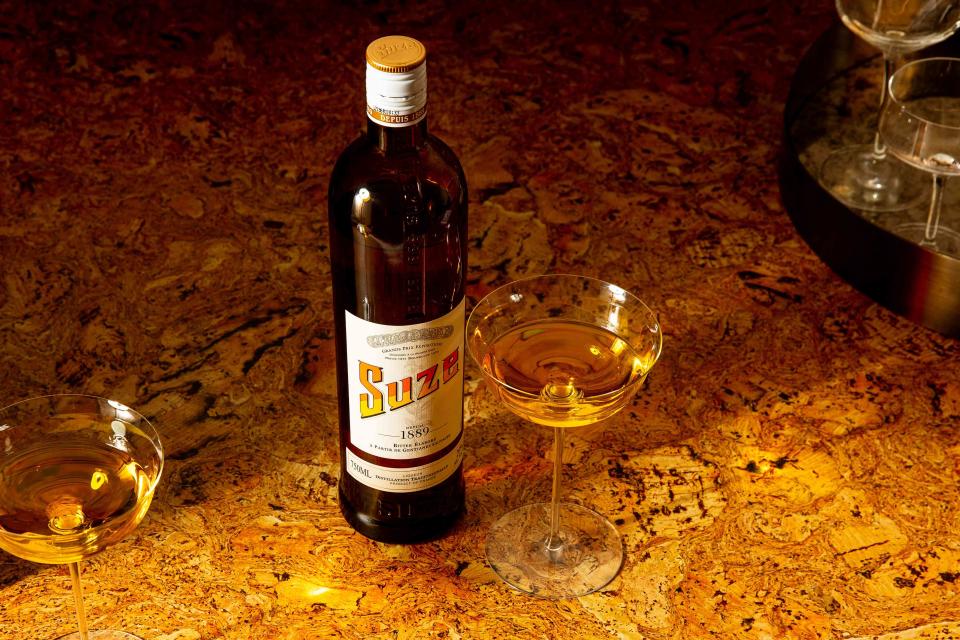Why Suze Is the Aperitif to Try
Campari and Aperol's paler cousin makes for a fantastic spritz.

Matt Taylor-Gross / Food Styling by Lucy Simon
Whenever I see a bottle of Suze, I can’t help but smile. For some, the smell of a burger being grilled outside or the first bite of a funnel cake at a fair might bring back memories of summer, but for me, it’s Suze. My best friends from college get together every summer for a weekend filled with lots of games, massive meals (spaghetti and meatballs for 15 is easy, I promise), and very good drinks. One summer, a friend brought a bottle of Suze. He grabbed it from the liquor store on one of our many hard seltzer runs because he said he liked the label. As a certified food and beverage geek, I knew exactly what this saffron-hued liqueur was and how to use it, but was a bit concerned it wouldn’t be to the liking of my just-out-of-college buddies. To my surprise, it was the first bottle to go empty. Everyone immediately fell in love with the herbaceous, bittersweet flavor of Suze. Some mixed it with gin and soda, vodka and lemonade, and even good old White Claw — no matter the combination, the verdict was clear: everyone loved Suze, and we haven’t had a summer reunion without a bottle of it since.
This French liqueur has a distinctive flavor, aroma and appearance that plays well with others in cocktails but is also delicious when sipped on its own. With a history that dates back well over 100 years, there’s a lot to know and love about Suze.
What is Suze?
The story of Suze dates back to late 19th century France. Distiller Fernand Moureaux sought out to create a new aperitif that was flavored with gentian, the root of a purple flower that has a slightly bitter and herbaceous flavor and was often used for its medicinal properties. Suze grew in popularity in France after being exhibited at the World’s Fair in Paris in 1889, and later caught on across bars and restaurants around Paris.
The aperitif has a gorgeous, golden yellow hue with a strong herbaceous aroma and bittersweet notes of tangerine and lemon, with just enough sweetness to create a rich mouthfeel and balance.
How is Suze made?
Chances are that you’ve already tried other aperitifs that use gentian root. This ingredient gives liqueurs like Aperol and Campari their necessary savory notes, and also flavors more vegetal aperitifs like Salers, or as well as more nouveau aperitifs like Lo-Fi’s Gentian Amaro. Gentian root grows deep and knotted in the ground, and can impart earthy, bitter notes as well as flavors like anise, tangerine, tarragon, and an unexpected minty freshness. To make Suze, gentian root is macerated in neutral alcohol for a year to fully impart its flavor. The infused spirit is distilled then blended with a variety of aromatic ingredients to create Suze’s complex flavor profile.
What does Suze taste like?
“Suze is aromatic, complex, and versatile, with a bitter, earthy, and slightly floral flavor profile,” says Keith Larry, who helms the bar at Little Rascal, a cutting-edge cocktail bar in Brooklyn’s Greenpoint neighborhood. Suze has a gentle warming sweetness and a soft finish. It clocks in between 15-20% alcohol by volume, much like Aperol and Campari.
How to drink Suze
Indulge in some Suze during l’apéro dînatoire, the ultra-chic, ultra-French meal that melds cocktail hour and dinner into one liqueur-laden, snack-heavy celebration. It’s one of writer Rebekah Peppler’s favorite ways to entertain and the menu of crudites, charcuterie, and very good bread lends itself to being paired with bittersweet aperitifs like Suze. Peppler suggests adding a bit of tonic or soda water to cut through Suze’s natural bitterness or do as the French do and enjoy it over ice with a wedge of lemon. A simple highball is also a tried and true way to enjoy Suze.
Best Suze cocktails
Given Suze’s aromatic complexity it's no surprise that it is a favorite ingredient for many professional bartenders. “One of my favorite ways to use Suze is in a White Negroni,” says Larry. Though more pale yellow than truly white, the White Negroni is a riff on the classic Negroni, and substitutes Suze for bright red Campari plus floral Lillet Blanc for sweet vermouth. “The result is a lighter and more herbal drink. Suze’s inherent bitterness adds complexity and depth to the cocktail while ensuring it remains true to the Negroni’s character,” he says.
While Suze’s herbal flavor profile lends itself to pairing with juniper-laden gin, it plays well with a variety of flavors and ingredients. Suze is a natural fit for spritzes, low-ABV cocktails and higher-proof drinks alike. “It pairs well with vegetable juices like carrot or even red pepper, the bitterness balances out some of the vegetal sweetness,” adds Larry.
Whether you enjoy Suze in a classic White Negroni, in an aperitif glass, or poolside mixed into a can of orange hard seltzer, Suze deserves a spot on your bar cart and will quickly find its way into many of your cocktails.
For more Food & Wine news, make sure to sign up for our newsletter!
Read the original article on Food & Wine.

